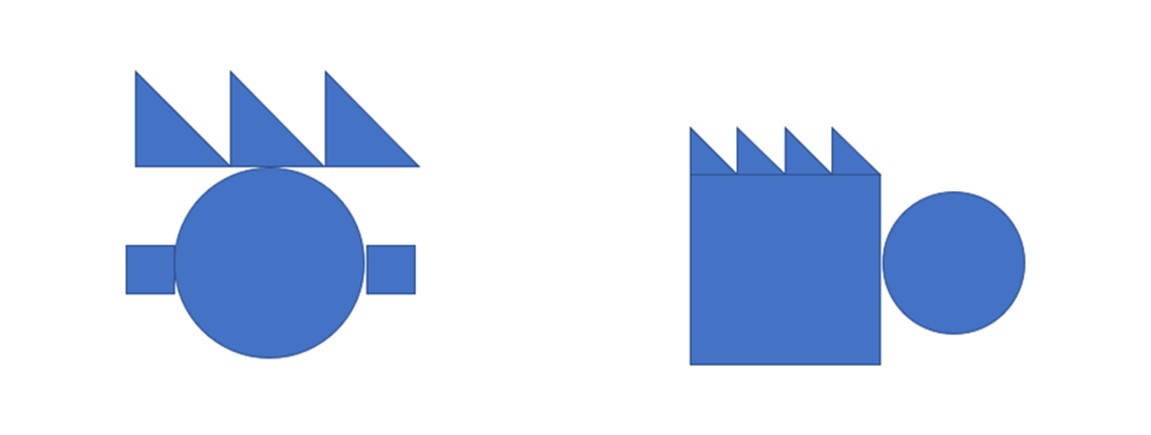When faced with the question of which shape has the largest area, our intuitive responses may vary. Some argue for the shape on the left, while others insist on the shape on the right. However, the true answer lies in meticulously measuring each tiny shape and adding up their respective areas. Similarly, in the hiring process, hiring managers cannot rely solely on intuition to identify the best candidate during an interview. To make successful hiring decisions, they must recognize that analyzing and evaluating every single characteristic that matters for predicting success is crucial, just as measuring each tiny shape accurately determines the true area.
This intriguing parallel between geometry and hiring reveals a fundamental flaw in the way hiring decisions are often made. Hiring managers, much like those who misjudge geometric shapes, often fail to measure each candidate's "little shapes" accurately, leading to flawed decision-making. Using the geometry analogy, let’s examine below the common mistakes made by hiring managers.

4 common mistakes in the traditional hiring system
Mistake 1: Not measuring all shapes
One common mistake in candidate evaluation is the failure to measure all the relevant characteristics, which is akin to overlooking certain shapes in geometry. Just as some shapes may be left unmeasured, hiring managers often forget or neglect to assess important attributes that contribute to a candidate's potential success. This oversight may arise from a lack of understanding of how to effectively measure these characteristics. However, unlike geometry where all shapes are visible, in a job interview, many crucial traits remain hidden or challenging to assess directly. To make accurate hiring decisions, it is imperative to develop comprehensive assessment methods that encompass all the relevant shapes or characteristics and uncover the hidden potential in candidates.
Mistake 2: Exaggerating the importance of minor shapes
Another common mistake in candidate evaluation is assigning undue significance to certain aspects of the applicant that have limited relevance, akin to magnifying the importance of insignificant shapes in geometry. For instance, job experience is often overemphasized as a predictor of job performance, despite evidence showing its limited correlation (consider the example of Carlos Alcaraz, the 20-year-old tennis prodigy who outshines many more experienced players). This tendency stems from the intuitive appeal of experience but fails to consider the diminishing returns of experience alone. Just as focusing excessively on insignificant shapes distorts the overall assessment of a geometric figure, disproportionately valuing certain characteristics in hiring decisions can skew the evaluation of a candidate's true potential. To make more accurate judgments, hiring managers should prioritize the assessment of comprehensive and meaningful competencies, giving appropriate weight to each aspect of a candidate's profile.
Mistake 3: Measuring all shapes in the same way
Another critical mistake in candidate evaluation is the tendency to measure all characteristics in the same manner, disregarding their unique nature and assessment requirements. You need different mathematical formulas to measure different shapes and the same is true of hiring. Indeed, various competencies and qualities in candidates necessitate tailored assessment methods. For instance, while the area of squares and triangles can be measured using formulas based on their sides and heights, the area of circles requires the use of the formula πr², considering the radius. Technical skills may be effectively evaluated through work sample tests, while interpersonal skills may require structured interviews or simulations. Similarly, when it comes to measuring intelligence, standardized psychometric tests like IQ assessments are commonly employed, as they provide reliable indicators of cognitive abilities and problem-solving skills. By adopting a one-size-fits-all approach to measurement, hiring managers overlook the nuances and intricacies of each characteristic, leading to incomplete or inaccurate evaluations. To ensure a comprehensive assessment, it is essential to recognize the diversity of shapes, or rather competencies, and employ appropriate measurement techniques for each.
Mistake 4: Neglecting the sum of the parts in candidates evaluation
Even if recruiters have measured all the characteristics they deemed important, they might still struggle to aggregate and synthesize their measures effectively. This can result in recruiting teams engaging in futile debates, resembling a committee arguing about which shape is the largest in geometry. One person might argue, "Shape A has a larger circle, so it must be the largest," while another counters, "Yes, but look, the square in shape B is much bigger." Both individuals are right to some extent, but the true determinant of size is not the individual shapes themselves—it is the total area. To determine the largest shape, one must add up the areas of each tiny shape. Similarly, in the hiring process, it is crucial to measure each characteristic and assess the potential of each candidate across all those attributes. Just as in geometry, the true evaluation lies in calculating the comprehensive value rather than fixating on isolated characteristics. By neglecting to calculate the total area, hiring managers miss the opportunity to comprehensively evaluate a candidate's suitability for a role.
Why combining geometry and hiring makes sense
In conclusion, the parallels between geometry and hiring shed light on the importance of meticulous measurement and comprehensive evaluation. Hiring managers must learn from geometric principles and recognize that intuition alone cannot guide effective decision-making. Each candidate's "little shapes" must be measured using appropriate methods, and their cumulative potential across various competences must be accurately assessed. By avoiding common mistakes and applying a weighted evaluation approach, hiring decisions can become more reliable and informed. Embracing the science of hiring ensures that the most promising candidates are selected based on the complete picture they present, rather than relying on single characteristics or limited information.
